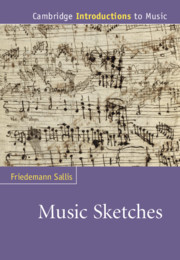Book contents
- Frontmatter
- dedication
- Contents
- List of figures
- List of music examples
- List of tables
- Preface
- Chapter 1 Introduction
- Chapter 2 Sketch studies past and present
- Chapter 3 Tracking down evidence of the creative process
- Chapter 4 The physical objects of the compositional process
- Chapter 5 Studying loose leaves
- Chapter 6 Sketchbooks
- Chapter 7 Transcription and facsimile reproduction
- Chapter 8 Sketches and the critical edition of music
- Chapter 9 Dangerous liaisons: the evolving relationship between sketch studies and analysis
- Chapter 10 Musical palimpsests and authorship
- Appendix: Beethoven sketchbooks published between 1913 and 2013
- Notes
- Glossary
- Bibliography
- Index
Chapter 6 - Sketchbooks
Published online by Cambridge University Press: 05 February 2015
- Frontmatter
- dedication
- Contents
- List of figures
- List of music examples
- List of tables
- Preface
- Chapter 1 Introduction
- Chapter 2 Sketch studies past and present
- Chapter 3 Tracking down evidence of the creative process
- Chapter 4 The physical objects of the compositional process
- Chapter 5 Studying loose leaves
- Chapter 6 Sketchbooks
- Chapter 7 Transcription and facsimile reproduction
- Chapter 8 Sketches and the critical edition of music
- Chapter 9 Dangerous liaisons: the evolving relationship between sketch studies and analysis
- Chapter 10 Musical palimpsests and authorship
- Appendix: Beethoven sketchbooks published between 1913 and 2013
- Notes
- Glossary
- Bibliography
- Index
Summary
Notebooks in the Renaissance
During the late Middle Ages, bound books, intended mainly for accounting purposes, were occasionally used by minor notables and merchants to record observations of special events that enlivened an otherwise monotonous existence. In the Renaissance, small notebooks began to be used by individuals we would describe as artists, writers or engineers to formulate, elaborate and conserve ideas. This practice spread rapidly across Europe, creating a ‘notebook’ culture that became ubiquitous in all aspects of writing. The most famous examples are those of Leonardo da Vinci. Approximately 6,500 leaves of texts and drawings survive, representing a small portion of the written material Leonardo is believed to have produced in his lifetime. A small number of the surviving notebooks were written with great care and are focused on one particular subject (though they also contain notes, memoranda and drawings on other topics). Most contain collections of drawings (sketches and drafts) as well as texts (fragments, anecdotes, quotations, paraphrases, lists) on a wide variety of topics including music and appear to have been notated and compiled quite chaotically. The heterogeneous content of the larger group is reminiscent of the portfolios or collections of papers that served as collective sketchbooks in the studios of painters and sculptors in Renaissance Italy. Initially, these portfolios were the common property of the assistants and pupils, who used them to try out ideas. During the fifteenth century, these ‘open’ documents tended to become an artist’s personal aide-mémoire.
At the same time, new humanist educational practice, particularly in northern Europe, resulted in the emergence of the so-called commonplace book: notebooks in which students transcribed quotations under pre-established headings (i.e. the ‘loci communes’ from which the term ‘commonplace’ is derived). This technique was also used in music education. Johannes Frosch (ca. 1470–after 1532) recommended that his students select the best passages of music by good composers and organise them in systematic collections, ‘so that when the need for them will come to you, you will have them ready’. Jesse Ann Owens believes that ample evidence exists of composers using notebooks that functioned both as commonplace books and as sketchbooks in which they copied well-crafted passages, jotted down ideas and worked out technical problems.
- Type
- Chapter
- Information
- Music Sketches , pp. 97 - 118Publisher: Cambridge University PressPrint publication year: 2015

